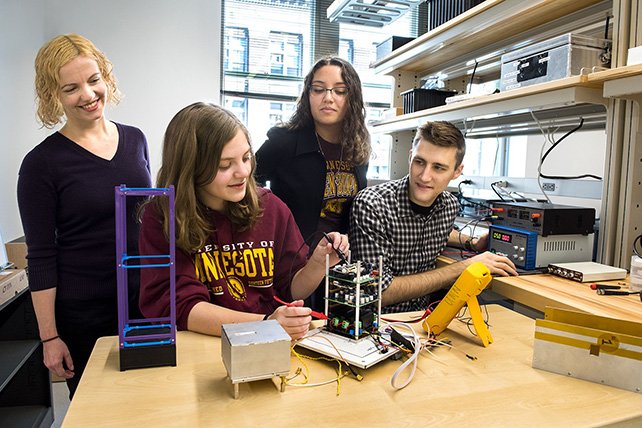NASA-funded satellite project launches young scientists' careers

Student-built telescope to study solar flares that can wreak havoc on spacecraft and power grids
November 20, 2017
When Abi Valero attended the Girl Scout space camp in Alabama, she never dreamed that in a few short years she’d be building a satellite of her own for NASA while still a college student.
Valero is chief engineer for EXACT, a University of Minnesota student project to study the sun’s corona by building, testing, and ultimately launching a shoebox-sized X-ray telescope. So far the students have twice flown and tested their handiwork in high-altitude balloons.
“I like that I’m taking what I learned in class and applying it to something that’s going to get launched into space,” said Valero, a junior aerospace engineering and mechanics major in the University's College of Science and Engineering.
“What I enjoy most about this project is that I get hands-on experience with how to code and how to work with electrical boards in depth, and before I would learn them in class,” said EXACT project manager Jenna Burgett, a sophomore physics major. “You really learn that from experience.”
EXACT is funded by NASA and the U.S. Air Force through student-training programs involving small satellite payloads. Part of the U of M's Small Satellite Project, it engages dozens of University of Minnesota undergrads, plus graduate students in advisory roles.
Corona in the crosshairs
The students plan to rocket their telescope high into the atmosphere to study small but common coronal explosions called flares, using clues in the X-rays they emit.
“We want to know how flares accelerate particles that can wreak havoc on spacecraft and, rarely, Earth’s power grids,” said Lindsay Glesener, an assistant professor in the School of Physics and Astronomy who co-leads the EXACT project along with Department of Aerospace Engineering and Mechanics Professor Demoz Gebre-Egziabher. “We also want to find out how billions of these flares collectively heat the sun’s corona to millions of degrees—hundreds of times hotter than the sun’s surface,” Glesener added.
If EXACT helps solve these mysteries, Glesener wants the credit to go to the young researchers.
“This is very much a student-run project,” she notes. “They do everything.”
To learn more about the students and their satellites, visit the University of Minnesota Small Satellite Project website.
If you'd like to support University of Minnesota College of Science and Engineering student projects like EXACT, visit our CSE Giving website.
